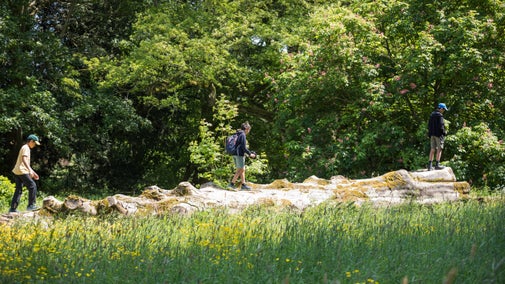
Discover more at Stonehenge Landscape
Find out how to get to Stonehenge Landscape, where to park, the things to see and do and more.

Follow in the footsteps of the people who built Stonehenge Landscape 4,500 years ago. Visit prehistoric monuments and former settlements surrounding the famous stone circle. The National Trust cares for over 800 hectares of land within this World Heritage Site and visitors can wander freely across the grasslands. These provide habitat for wildlife so look out for wild deer, hares or maybe a greater spotted woodpecker along the way.
Head out into the Stonehenge Landscape and away from the sights and sounds of modern life to appreciate the feeling of space. The monuments at Stonehenge remain deeply connected to each other and to the living landscape.
It’s a place to relax and wander, whether on a journey of self-discovery or to explore the natural world at its best.

The area's chalk grassland is one of the most diverse habitats in Wiltshire. There are stunning displays of wild flowers that provide nectar sources for insects during the warmer months of the year.
The ongoing grassland reversion project is bringing more and more species back to this landscape, where in recent years there was just arable and pasture farmland.
The landscape is home to many animals, including deer, hare, a wide variety of birds and increasing diversity in flora and insects.
The small woodlands turn golden and bronze in autumn, as the ash and beech leaves turn. The rattling call of the fieldfare and whistling call of the redwing can be heard as they announce their arrival from northern Europe.
Exploring the woodlands will reveal different types of fungi, such as King Alfred's cakes, earth stars and jelly ear, and the grasslands are a good place to find toadstools. Meanwhile, the landscape's hedgerows boast berry-rich bushes, such as hawthorn, buckthorn, spindle and wayfaring tree.
For those who love woodland areas for a walk, King Barrow Ridge has Bronze Age burial mounds that stand among ancient beech trees, with views of Stonehenge and the downs.
King Barrow Ridge is home to common lizards and slow-worms living among the timeworn tree stumps. The long grass is a perfect hunting habitat for owls and the veteran trees provide great perches.
Meanwhile, the hazel coppice and mixed woodland provides shelter and food for small mammals, the great spotted woodpecker and the green woodpecker.
- Keith Steggall, National Trust Wiltshire landscape ranger
The gigantic bank and ditch forming the Neolithic henge was built to mark the area that had only a generation before been home to the builders of Stonehenge. This huge circular earthwork is 500m across and, at one point, contained timber structures like nearby Woodhenge.
Archaeologists have discovered the remains of houses, timber circles and a broad track flanked by banks and ditches leading to the River Avon.
Some 4,000 years ago, thousands of people travelled long distances to gather here. Hundreds of arrowheads have been found in the Durrington Walls area, some of which were used to shoot domestic pigs. These were then eaten at great midwinter feasts.

This impressive bank-and-ditch earthwork is more than 1.5 miles long. It may have been the ceremonial route and entrance to the stone circle – recent excavations suggest the Avenue even predates it. Though much eroded, it can still be seen on its final approach to the stone circle.
The Winterbourne Stock Barrows is a resting place for some of the most important people of the Bronze Age. This impressive barrow group contains every style of barrow to be found in southern England.
This enormous earthwork is one of the best preserved in Britain. It was built over 5,000 years ago using simple antler picks to dig out the chalk and earth.
The huge rectangular enclosure stretches for nearly two miles and predates Stonehenge by hundreds of years. While its ceremonial or ritual use remains a mystery, many believe it may have been used for processions.
This mysterious unshaped lone sarsen stone is known as the Cuckoo Stone and lies only a few metres from where it once stood upright. It would have been the focus of rituals and ceremonies from the Neolithic period to Roman times.
It's rare to find examples of naturally occurring sarsen stones like this one. Most of the stones used at Stonehenge are thought to have come from the Marlborough Downs, which is 20 miles to the north.
In their simplest form round barrows are giant mounds of chalk, earth or turf, which were placed over burials and sometimes cremations during the Bronze Age. The Stonehenge Landscape contains the densest concentration of round barrows anywhere in Britain.
On the way to Stonehenge on the visitor shuttle service, you can get off at nearby Fargo Wood. Less than a mile from the stone circle, here there are ancient burial mounds and lots of wildlife to discover.

Find out how to get to Stonehenge Landscape, where to park, the things to see and do and more.
Discover the history of Stonehenge Landscape and learn more about the area that surrounds this World Heritage Site.

Managing the Stonehenge Landscape, Wiltshire requires a careful balance of looking after the archaeology and nature while still making it accessible for visitors.

Follow the latest updates and our position on the A303 Road Improvement Scheme at Stonehenge.
The National Trust allows free permissive access in the Stonehenge Landscape and dogs are welcome. However, there will be occasions where we have to restrict where you can walk your dog.

Plan a visit to one of the special countryside places in our care and discover the benefits of being in the great outdoors. Pack your walking boots and get ready to explore woodlands, valleys and rivers.

Wiltshire has a vast amount of countryside to explore including woodlands and trails. Get outside and enjoy the space with your family and friends.

Explore some of the finest landscapes in our care on coastal paths, accessible trails, woodland walks and everything in between. Find the best places to walk near you.
